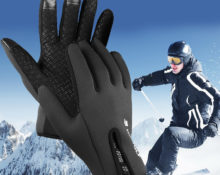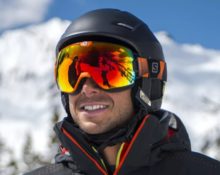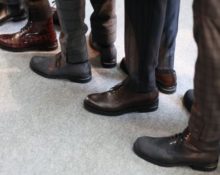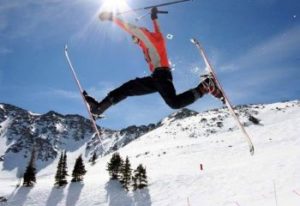 When purchasing ski equipment, the most important and difficult process is the selection of suitable ski boots. This is the first thing you have to put on before you start skiing.
When purchasing ski equipment, the most important and difficult process is the selection of suitable ski boots. This is the first thing you have to put on before you start skiing.
Well-chosen shoes of this kind will provide reliable support for the feet and ankles, adequate control over the skis and a fairly high level of comfort, especially when skiing for many hours.
How to choose the right ski boot size?
Before you start choosing ski boots, It is recommended to correctly determine your foot size in centimeters. Many people often prefer to purchase shoes one size larger than required. In the situation with ski boots, this does not work.
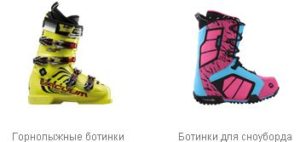 Shoes of this kind must fit on the foot like roller skates or regular skates: securely and firmly. Excessive length in this case will do nothing but harm.
Shoes of this kind must fit on the foot like roller skates or regular skates: securely and firmly. Excessive length in this case will do nothing but harm.
Reference! It is believed that larger shoes will provide less fatigue to the feet.This is a big misconception. When operating skis in shoes that are too loose, you will have to exert much more effort.
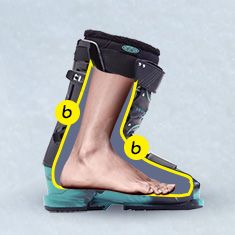 To independently determine your shoe size, you must:
To independently determine your shoe size, you must:
- put a sheet of paper on the floor;
- step on the paper, while relaxing your foot;
- Without lifting your feet from the sheet, mark your heel and longest toe;
- measure the distance between them using a ruler;
- measure the other leg in the same way.
The largest result obtained will be the size of the foot. The most accurate size that you should focus on when choosing ski boots is the size in centimeters.
Size Chart for Men, Women and Children:
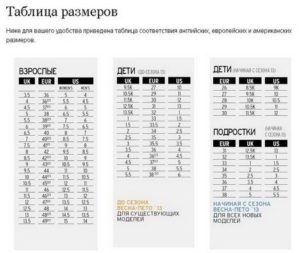 Having determined the length and width of the foot, the specialist will be able to select the most suitable options, thereby significantly reducing the expected search range. Subsequently, the acceptable width of such shoes is determined individually during the fitting process.
Having determined the length and width of the foot, the specialist will be able to select the most suitable options, thereby significantly reducing the expected search range. Subsequently, the acceptable width of such shoes is determined individually during the fitting process.
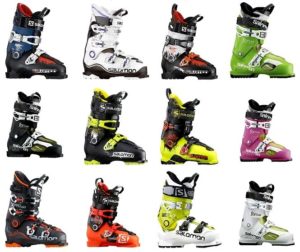 If your feet feel a little cramped in the chosen shoes, this is not a big deal. Any shoe sooner or later “crinkles” under your foot, becoming more comfortable.
If your feet feel a little cramped in the chosen shoes, this is not a big deal. Any shoe sooner or later “crinkles” under your foot, becoming more comfortable.
Ski boot stiffness
This indicator is determined by the ski boot’s resistance to bending forward. In most cases, the stiffness of such shoes is indicated directly in its characteristics.
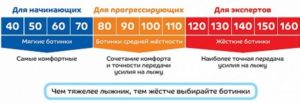 The following factors influence the determination of the optimal level of rigidity:
The following factors influence the determination of the optimal level of rigidity:
- weight and height of the skier;
- riding style;
- degree of preparation;
- place chosen for skiing.
Influence of riding style
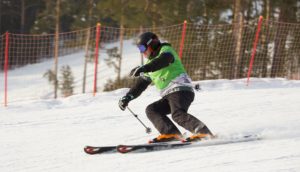 For each riding style, certain parameters matter. Soft ski models guarantee maximum comfort, while hard ones provide better control over the skis.
For each riding style, certain parameters matter. Soft ski models guarantee maximum comfort, while hard ones provide better control over the skis.
For intensive skiing, it is better to choose rigid models, equipped with fasteners to secure the leg at the four most vulnerable points, and with sufficient strength.
For freestyle, models with a double shock-absorbing sole are suitable for safely performing various tricks and jumps. These ski shoes generally have metal clips that can withstand strong shocks and loads.
The influence of a skier's weight and height on the choice of ski boots
 The greater the weight of the skier, the higher the stiffness index of shoes of this kind must be. During the fitting process, ski boots must bend slightly under the pressure of the person trying them on.
The greater the weight of the skier, the higher the stiffness index of shoes of this kind must be. During the fitting process, ski boots must bend slightly under the pressure of the person trying them on.
His height is also of great importance. The higher it is, the greater the value the optimal stiffness indicator should have. It is also necessary to take into account when choosing that the stiffness of shoes in a warm store is felt much lower than in conditions of low temperatures.
Important! Ski shoes from different manufacturers with the same stiffness rating can have significant differences. Everyone's effort increases differently, not in a linear fashion.
The level of physical fitness of the skier plays an important role. For beginners, the optimal indicator would be a hardness index in the range of 60-80 units.
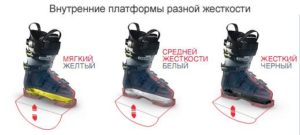 For intermediate and advanced skiers, the best choice would be shoes with a stiffness index of 85-100. Experts in most cases choose an index in the range of 110-120, and for athletes the best option would be a hardness index of 130-140 units.
For intermediate and advanced skiers, the best choice would be shoes with a stiffness index of 85-100. Experts in most cases choose an index in the range of 110-120, and for athletes the best option would be a hardness index of 130-140 units.
Influence of the type of sport and place of skiing
Depending on their functional purpose, ski boots, like skis, have certain features:
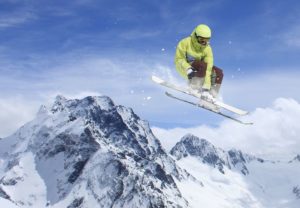 Sport — maximum level of hardness; block having a narrow width; relatively thin inner boot and greater forward tilt angle;
Sport — maximum level of hardness; block having a narrow width; relatively thin inner boot and greater forward tilt angle;
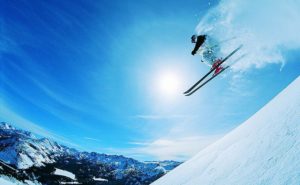 Freeride - in most cases, a less significant forward slope formed by the boot; a block having a medium-sized width; thicker inner boot; the hardness indicator does not play a special role in this case;
Freeride - in most cases, a less significant forward slope formed by the boot; a block having a medium-sized width; thicker inner boot; the hardness indicator does not play a special role in this case;
A park — low level of rigidity, presence of shock-absorbing inserts, low weight.
Ski boot last
When determining a suitable last, it is necessary to take into account the skiing style and the individual characteristics of the skier's feet. In different models, the width of the last (Last) can range from 95 to 104 mm (the distance between the walls of the boot in the widest part of the foot). There is no general standard, as is the case with the stiffness of these shoes.
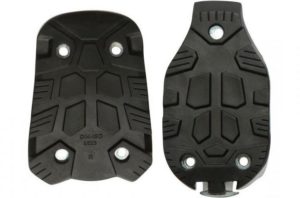 Conditionally ski boot last can be attributed to one of three groups:
Conditionally ski boot last can be attributed to one of three groups:
- narrow – 95-98 mm;
- average – 100-102 mm;
- wide – 102-104 mm.
Important! In some models, the width of plastic boots may vary (manufacturer: Head Adaptive Fit). Thermoforming the inner boot solves this problem.
Ski boot design
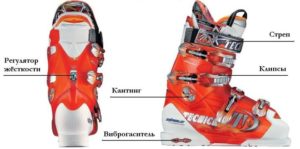 Professional ski shoes have a special design:
Professional ski shoes have a special design:
- outer boot made of plastic: molded or non-molded;
- a power belt is usually a Velcro strap or a booster with a metal buckle;
- inner boot - a soft boot that provides comfort to the foot;
- sole – TLT (Dynafit standard for ski touring and ski mountaineering) or WTR (Salomon and Atomic standard for backcountry and skiing on prepared trails);
- clip - a fastener on the outer boot for fixing the leg.
What to look for when buying ski boots?
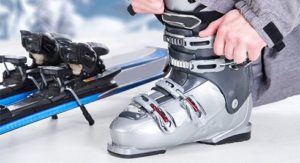 The main thing in choosing ski boots is size. It depends on two mandatory indicators: foot length and width. The length can be measured at home yourself, and the width is determined directly during the fitting process.
The main thing in choosing ski boots is size. It depends on two mandatory indicators: foot length and width. The length can be measured at home yourself, and the width is determined directly during the fitting process.
Experienced freeriders and fans of dynamic karting driving will certainly appreciate possibility of bending the boot at the metatarsus, which is not inherent in all models.
It is not recommended to skimp on the choice of sole material. A sole made of metal, although more expensive, will also last much longer.
Walk-Ride Switch
Using this function, you can fix or release the stop that controls the forward tilt of the shoe cuff.
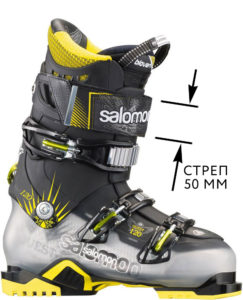
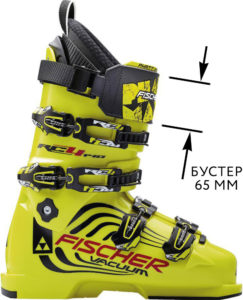 It can be placed both on shoes designed for freeride/backcountry/ski touring, and on comfortable, recreational options.
It can be placed both on shoes designed for freeride/backcountry/ski touring, and on comfortable, recreational options.
Insulation
The base of the liner, made of foam material, is responsible for maintaining heat in ski boots. The heat level directly depends on the thickness of the liner.
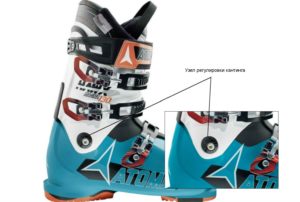 The insulation area varies. This can be the entire liner or just the toe area. The extra plush layer provides increased levels of warmth and comfort.
The insulation area varies. This can be the entire liner or just the toe area. The extra plush layer provides increased levels of warmth and comfort.
Advice! For ski boots, it is recommended to purchase special moisture-wicking socks to prevent chafing of the shin. The use of ordinary cotton or woolen socks with such shoes is unacceptable.
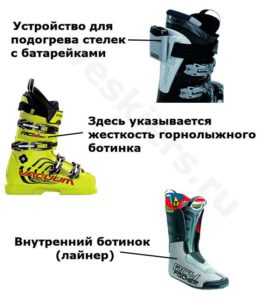 If your feet feel cold in your ski boots, it may be because the shoe size is incorrect and the boots fit too loosely on your feet. Another reason for freezing may be too narrow shoes. In this case, blood vessels or nerve fibers may be pinched.
If your feet feel cold in your ski boots, it may be because the shoe size is incorrect and the boots fit too loosely on your feet. Another reason for freezing may be too narrow shoes. In this case, blood vessels or nerve fibers may be pinched.
The fitting process should not take less than 15-20 minutes. If during this time there is no feeling of tightness in the legs, numbness and burning, this is an excellent model. When choosing unisex ski boots, you need to know that such shoes do not take into account all the structural features of the foot, so they are not suitable for everyone.


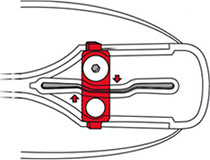 Important! In some models, the width of plastic boots may vary (manufacturer: Head Adaptive Fit). Thermoforming the inner boot solves this problem.
Important! In some models, the width of plastic boots may vary (manufacturer: Head Adaptive Fit). Thermoforming the inner boot solves this problem. 0
0